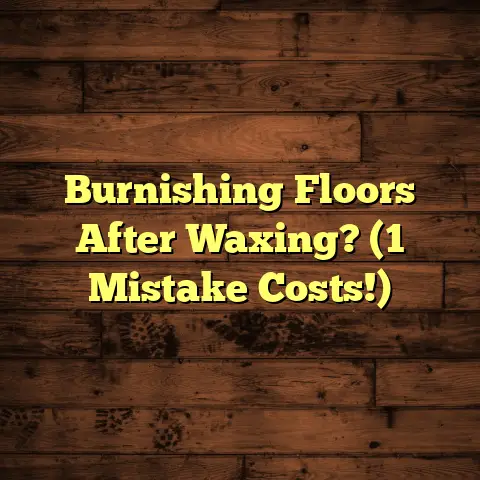Hardwood Flooring Cost? (2 Price Factors!)
Have you ever walked into a beautifully designed home and thought, “Wow, that hardwood flooring is stunning!” But then the question pops into your head: “How much did all of this really cost?”
I get it. As a flooring contractor for over 15 years, I’ve seen the sticker shock on people’s faces. Hardwood flooring is an investment, no doubt. But understanding the factors that drive the price can help you make informed decisions and avoid those “gulp” moments.
Understanding Hardwood Flooring: An Overview
Hardwood flooring brings a warmth and elegance to any space that’s hard to replicate with other materials. Its timeless appeal and durability make it a popular choice for homeowners looking to add value and beauty to their homes.
But what exactly is hardwood flooring? Simply put, it’s flooring made from a single piece of wood, typically from deciduous trees like oak, maple, or cherry.
Now, you’ll often hear about two main types: solid hardwood and engineered hardwood. Here’s the lowdown:
-
Solid Hardwood: This is the classic choice – one solid piece of wood from top to bottom. It can be sanded and refinished multiple times, making it incredibly long-lasting.
-
Engineered Hardwood: This is made up of layers of plywood or fiberboard with a veneer of real hardwood on top. It’s more stable than solid hardwood, making it a good option for basements or areas with high moisture.
Cost Breakdown of Hardwood Flooring
Okay, let’s get down to brass tacks: How much is this actually going to cost you?
The total cost of hardwood flooring boils down to two primary factors:
-
Material Costs: The type of wood you choose, its quality, and the amount you need will significantly impact your budget.
-
Installation Costs: Whether you decide to DIY or hire a professional installer, labor costs will play a crucial role in the final price.
Let’s dive deeper into each of these factors.
Material Costs in Detail
The material cost is where you’ll see the biggest variations in price. Think of it like buying a car – a basic sedan is going to cost a lot less than a luxury sports car, right? Same goes for hardwood!
Here’s a breakdown of some common wood species and their approximate price ranges per square foot (Keep in mind that these are just averages, and prices can fluctuate based on location and market conditions):
| Wood Species | Price Range (per sq ft) | Characteristics |
|---|---|---|
| Oak | \$3 – \$8 | Durable, classic look, readily available, takes stain well. |
| Maple | \$4 – \$9 | Hard, smooth grain, lighter color, can be tricky to stain evenly. |
| Hickory | \$5 – \$10 | Very hard and durable, rustic appearance, distinct grain patterns. |
| Cherry | \$6 – \$12 | Rich, reddish-brown color, elegant grain, can darken with age. |
| Walnut | \$8 – \$15 | Dark, luxurious color, beautiful grain, softer than oak or maple. |
| Exotic Woods | \$10 – \$30+ | (Brazilian Cherry, Tigerwood, etc.) Unique colors and grain patterns, often more expensive due to import costs and scarcity. |
Source: Based on my experience and averages from major flooring retailers like Home Depot and Lowe’s.
Important Note: These prices are for the materials only. They don’t include underlayment, adhesives, or finishing products.
Beyond the Species:
It’s not just the type of wood that affects the price, but also the grade and quality. Hardwood is graded based on its appearance, the number of knots and imperfections, and the consistency of its color.
-
Clear Grade: Minimal knots and imperfections, very uniform in color – the most expensive grade.
-
Select Grade: Few small knots and color variations, still a very clean look.
-
Common Grade: More knots and color variations, more rustic appearance – the most affordable grade.
Market Trends and Sustainability:
Keep an eye on market trends. If a particular wood species becomes trendy, demand goes up, and so does the price.
Also, consider sustainability. Sustainably harvested wood might cost a bit more, but you can feel good knowing you’re making an environmentally responsible choice. Look for certifications like the Forest Stewardship Council (FSC) label.
Real-World Example:
I recently worked on a project where the homeowner initially wanted Brazilian Cherry (an exotic hardwood) for their entire first floor. After getting a quote, they were floored (pun intended!) by the price. We ended up exploring alternatives and settled on a high-quality engineered oak with a similar stain, saving them thousands of dollars without sacrificing the look they wanted.
Installation Costs Explained
Okay, you’ve picked out your dream hardwood flooring. Now comes the installation. This is where labor costs come into play.
The installation process typically involves:
-
Subfloor Preparation: Making sure the existing floor is level, clean, and dry.
-
Underlayment Installation: Adding a layer of padding for sound insulation and moisture protection.
-
Laying the Flooring: The actual process of installing the hardwood planks or strips.
-
Finishing: Adding a protective coating to the floor (sanding, staining, and sealing).
DIY vs. Hiring a Professional:
This is a big decision. DIY can save you money, but it also requires time, skill, and the right tools. Hiring a professional ensures the job is done right, but it comes at a cost.
Here’s a quick comparison:
| Feature | DIY | Hiring a Professional |
|---|---|---|
| Cost | Lower upfront cost (you only pay for materials), but potential for costly mistakes if you’re not experienced. | Higher upfront cost (includes labor), but reduces the risk of errors and potential rework. |
| Time | Can take significantly longer, especially if you’re new to flooring installation. | Faster installation, as professionals have the experience and tools to complete the job efficiently. |
| Skill Required | Requires a good understanding of flooring installation techniques, proper use of tools, and attention to detail. | No skill required on your part, as professionals handle all aspects of the installation. |
| Warranty/Guarantee | No warranty on the installation itself (if you make a mistake, you’re responsible for fixing it). | Professionals typically offer a warranty on their work, so if there are any issues after installation, they’ll fix them. |
| Stress Level | Can be stressful, especially if you encounter unexpected problems. | Less stressful, as you can leave the entire project in the hands of experienced professionals. |
| Tool Investment | Requires purchasing or renting specialized tools like a flooring nailer, tapping block, and saw. | Professionals already have all the necessary tools and equipment. |
| Potential Savings | Opportunity to save a significant amount of money on labor costs. | Little to no savings on labor costs, but potential for long-term savings due to professional installation and warranty. |
| Overall Risk | Higher risk of mistakes, uneven flooring, or other issues that could require rework. | Lower risk of mistakes, as professionals have the experience and expertise to handle any challenges that may arise. |
| Learning Curve | Opportunity to learn a new skill and gain experience in home improvement. | No learning curve, as you’re relying on the expertise of professionals. |
| Project Control | Complete control over the project, from start to finish. | Less control over the day-to-day details of the project, but professionals will keep you informed and involved in key decisions. |
| Peace of Mind | Potential for anxiety and stress if you’re not confident in your abilities. | Greater peace of mind, knowing that the project is being handled by experienced professionals. |
How Much Does Professional Installation Cost?
On average, professional hardwood flooring installation can range from \$3 to \$8 per square foot for labor alone. This can vary depending on several factors:
-
Complexity of the Project: Intricate patterns, stairs, or working around obstacles will increase the cost.
-
Location: Labor costs tend to be higher in urban areas than in rural areas.
-
Experience of the Installer: More experienced and reputable installers will typically charge more.
-
Subfloor Preparation: If your subfloor needs significant repairs or leveling, that will add to the cost.
Hidden Costs to Watch Out For:
-
Subfloor Repairs: As I mentioned, if your subfloor is uneven or damaged, it needs to be fixed before installing the new flooring. This can add hundreds or even thousands of dollars to the project.
-
Old Flooring Removal: Tearing up and disposing of old flooring can also add to the cost. Some installers include this in their estimate, while others charge extra.
-
Moving Furniture: You’ll need to move all of your furniture out of the room before the installation begins. Some installers will do this for you, but they’ll charge a fee.
-
Waste Disposal: Make sure the installer includes waste disposal in their estimate. You don’t want to be stuck with a pile of old flooring in your driveway!
My Pro Tip: Get at least three quotes from different installers before making a decision. Make sure they’re licensed and insured, and check their references. Don’t just go with the lowest price – consider their experience and reputation as well.
Additional Factors Influencing Overall Cost
Beyond the material and installation costs, there are a few other factors that can affect the final price of your hardwood flooring project:
-
Location: As I mentioned earlier, labor costs vary by location. Material costs can also be higher in certain areas due to transportation costs.
-
Market Demand: If there’s a high demand for hardwood flooring in your area, prices may be higher.
-
Seasonal Trends: Flooring contractors are often busier in the spring and fall, so you might be able to get a better deal if you schedule your project during the off-season (winter or summer).
-
Project Size: The size of your project can also impact the price. Larger projects may qualify for bulk discounts on materials, but smaller projects may incur additional fees due to the installer having to bring their equipment to your home for a smaller job.
Conclusion
So, there you have it – a comprehensive breakdown of the two primary price factors that affect hardwood flooring costs: material costs and installation costs.
Understanding these factors is crucial for making informed decisions and staying within your budget. Remember to:
-
Research different wood species and grades to find the best option for your needs and budget.
-
Get multiple quotes from qualified installers.
-
Factor in potential hidden costs like subfloor repairs and old flooring removal.
-
Consider the long-term value of hardwood flooring. It’s an investment that can add beauty and value to your home for years to come.
Choosing hardwood flooring is a big decision, but with the right knowledge and planning, you can achieve that stunning look you’ve always dreamed of without breaking the bank. Good luck!





